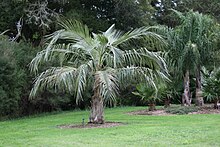Parajubaea cocoides
| Parajubaea cocoides | |
|---|---|

| |
| Scientific classification | |
| Kingdom: | Plantae |
| Clade: | Tracheophytes |
| Clade: | Angiosperms |
| Clade: | Monocots |
| Clade: | Commelinids |
| Order: | Arecales |
| Family: | Arecaceae |
| Genus: | Parajubaea |
| Species: | P. cocoides
|
| Binomial name | |
| Parajubaea cocoides | |
Parajubaea cocoides, the mountain coconut, coco Cumbe or Quito palm, is a species of flowering plant in the family Arecaceae. It occurs in Ecuador, Colombia and Peru.
Description
Palms up to 16 m tall, trunk up to 45 cm in diameter.[1][2] Leaves 3–4 m long, dark green above, grayish green beneath, with 60-70 pairs of segments or pinnae, the longest pinnae in the middle up to 70 cm long.[2][3] Inflorescence 1–2 m long, with 50-70 short branches.[2] Fruit ellipsoid, 4-5.5 cm long, 2.8–4 cm in diameter, greenish brown.[1]

Distribution and habitat
Known only from cultivation in the Andean valleys of southern Colombia and Ecuador at elevations of 2000–3000 m.[1][3] However, an alleged natural population was reported in a town in northern Peru at 1900 m.[4]
Uses
Parajubaea cocoides is cultivated as an ornamental palm for parks and avenues.[5] Outside its area of origin, it is found in cultivation in San Francisco, Sydney, Costa del Sol, northern New Zealand, and even the British Isles, where it has been successfully grown in Cornwall. [6][3][5] The seeds are edible and taste like coconut.[3][5]
References
- ^ a b c Henderson, Andrew; Galeano-Garces, Gloria; Bernal, Rodrigo (1997). Field Guide to the Palms of the Americas. Princeton University Press. p. 151. ISBN 0691016003.
- ^ a b c Borchsenius, Finn; Pedersen, Henrik Borgtoft; Balslev, Henrik (1998). Manual to the Palms of Ecuador. Department of Systematic Botany, Aarhus University in collaboration with Pontificia Universidad Católica del Ecuador. p. 153. ISBN 9788787600538.
- ^ a b c d Del Cañizo, Jose Antonio (2011). Palmeras (in Spanish). Mundi-Prensa Libros. ISBN 9788484763994.
- ^ Roca, F (2010). "Parajubaea cocoides, a new record for Peru". Palms. 54 (3): 133–136.
- ^ a b c National Research Council. (1989). Lost Crops of the Incas: Little-Known Plants of the Andes with Promise for Worldwide Cultivation. National Academy Press, Washington, D.C. p. 319-321
- ^ "Lamorran Gardens is something else!". European Palm Society. Retrieved 14 October 2022.
External links
- Palm and Cycad Society of Australia Parajubaea cocoides
- Palmpedia.net Parajubaea cocoides
